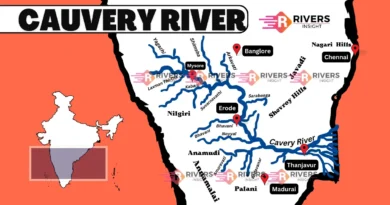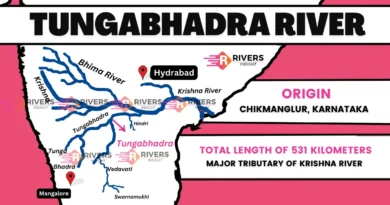Bharathapuzha River: Origin, Course, & Map of India
Bharathapuzha River
Bharathapuzha River is the second-longest river in Kerala, often called the “Nile of Kerala”. It originates in Tamil Nadu’s Anamalai Hills, flows westward through Kerala, and finally merges into the Arabian Sea near Ponnani.
Looking for the origin, course, or map of the Bharathapuzha River?
This article covers everything you need to know about Kerala’s second-longest river — from where it starts and ends, its major tributaries, map, and route, to the dams built across it and why it’s also called the Nila or the Nile of Kerala.
✅ Quick Facts of Bharathapuzha River
| Other Names | Nila, Ponnaniyar, Kuttippuram Puzha |
| Length | 209 km |
| Origin | Anamalai Hills, Western Ghats, Tamil Nadu |
| Mouth | Arabian Sea near Ponnani, Kerala |
| Major Tributaries | Gayathripuzha, Kalpathipuzha, Thuthapuzha, Tirur |
| Main Dams | Malampuzha, Aliyar, Thirumoorthy, Mangalam |
| Also Known As | Nile of Kerala |
Origin of Bharathapuzha River
The Bharathapuzha River originates in the Anamalai Hills of the Western Ghats, located in Tamil Nadu. These hill ranges give rise to numerous small rivulets, which eventually converge to form the main river. Though the river starts in Tamil Nadu, the majority of its journey flows through Kerala.
Course & Route
- Tamil Nadu Section:
- Begins in the Anamalai Hills, Coimbatore district
- Flows northwest through Pollachi Taluk
- Entry into Kerala:
- Crosses into Kerala through the Palakkad Gap — a major lowland pass in the Western Ghats
- Continues through Palakkad, Malappuram, and Thrissur districts
- End Point:
- Empties into the Arabian Sea near Ponnani
Why Nila or the Nile of Kerala?
The Bharathapuzha River is often referred to as “Nila” or the “Nile of Kerala” due to its profound cultural and ecological significance. Flowing through the heart of Kerala, it has shaped the region’s traditions, agriculture, and daily life. Much like the Nile River in Egypt, which has been central to Egyptian civilization, the Bharathapuzha has been a lifeline for the people of Kerala.
Drainage Basin & Rainfall
- Total Drainage Area: 6,186 km²
- In Kerala: ~4,400 km²
- In Tamil Nadu: ~1,786 km²
- Rainfall:
- Receives most of its rain from the Southwest Monsoon (June–September)
- Rainfall varies from 2,000–2,800 mm in hilly areas to 3,000 mm near the coast
Despite its size, Bharathapuzha has a relatively low water flow due to the dry climate in parts of its basin, especially in Tamil Nadu and the Palakkad region.
Major Tributaries of Bharathapuzha
| Tributary | Districts Drained | Key Facts |
|---|---|---|
| Gayathripuzha | Seasonal supports paddy fields | Longest tributary |
| Kalpathipuzha | Palakkad | Flows near Malampuzha |
| Thuthapuzha | Palakkad, Malappuram | Seasonal, supports paddy fields |
| Kannadipuzha | Mannarkkad | Significant for irrigation |
| Tirur River | Malappuram | Joins downstream |
| Pulanthode | Western Basin | Small seasonal stream |
Dams & Reservoirs
The river is heavily dammed, serving irrigation and water storage needs.
| Dam/Reservoir | Type | Notes |
|---|---|---|
| Malampuzha Dam | Reservoir | Largest in the basin |
| Aliyar Dam | Storage | Located in Tamil Nadu |
| Thirumoorthy Dam | Reservoir | On a tributary in TN |
| Mangalam Dam | Weir | Primarily for irrigation |
| Walayar, Meenkara | Multi-use | Local irrigation and flood management |
➡️ Total Constructions: 11 completed dams, 2 under development
Cultural & Historical Importance
Bharathapuzha is not just a river — it’s a cultural symbol.
- Thirunavaya: Sacred site of the historic Mamankam Festival
- Religious Rituals: Karkidaka Vavu Bali and other ancestral rites
- Literary Legacy: Inspired poets like Vallathol Narayana Menon and M. Govindan
- Temple Ghats: Dot the riverbanks with rituals happening year-round
Also Read: Chaliyar River of Kerala
This is all about the Bharathapuzha River — its origin, route, tributaries, dams, cultural importance, and why it’s known as the Nile of Kerala. If you think we missed any important detail or have something to add, feel free to share it in the comments. Your feedback helps us improve and bring better content to you!




